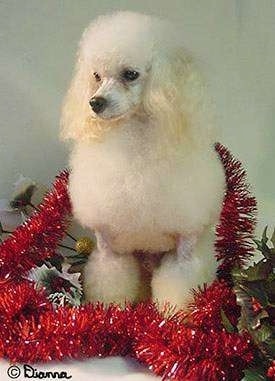

Poodles are intelligent, alert, and active. Historically, their aptitude has made them ideal for performing in circuses across the globe for centuries. Otherwise notable is this breed's keen sense for instinctual behavior. In particular, marking and hunting drives are more readily observable than in most other breeds. Even Toys will point birds. Classified as highly energetic, poodles can also get bored fairly easily and have been known to get creative about finding mischief.
Poodles are extremely people-oriented dogs and generally eager to please. They are excellent watchdogs, but unlike some working breeds, don't usually become "one-person" dogs when they are part of a family. Standard Poodles in particular tend to be good with children. Poodles are adaptable and easy to train. Like most dogs, they appreciate daily exercise, such as a walk or a play session. Most are fairly agile and athletic. Toy Poodles will play ball and love to fetch. Play time is vital, but one must be sure that they get plenty of rest following long play periods and that fresh water is available at all times.
Potty training can be difficult in many dogs, but the poodle is one of the easiest to train. Whether going outside or being trained on a pad, they learn quickly where to relieve themselves. However, they are still animals, and they need time to understand what you want from them. It may take a while, but poodles are quite smart and learn more quickly than most dogs.
The poodle breed is found in small, medium, and large sizes, and in many coat colors. Originally bred as a type of water dog, the poodle is skillful in many dog sports including agility, obedience, tracking, and even herding. Poodles are elegant in the conformation ring, having taken top honors in many shows, including Best in Show (BIS) at the Westminster show in 2002 and BIS at the World Dog Show in 2007. Most poodles have dense, curly, non-shedding hair (not fur) that grows year-round and requires regular grooming. Unlike most dogs, which have double coats, poodles have a single layer (no undercoat) of dense, curly fur that sheds minimally and could be considered hypoallergenic (though not completely allergen free). Texture ranges from coarse and woolly to soft and wavy. Most are solid-colored, and many registries only allow solid colors in conformation shows. "Parti" (short for parti-colored) poodles have large patches of colors different from the main body color. "Phantom" poodles have the color pattern of a black-and-tan dog, although not necessarily black and tan. Solid-colored poodles may either "hold" their color (i.e., stay more or less the same throughout their lives) or "fade" or "clear" to a lighter shade.
Usually the ears and the thicker guard hairs hold more of the original color than other hair. The tail is usually docked in the US, less often in Europe, and tail docking is now illegal in the UK. These days, tails, when docked, are left much longer than in times past. "Bunny like tails" (very short-docked tails) are now rarely seen except among puppy mill pet shop dogs. Poodles have drop ears, which are never cropped.
Unlike many breeds, poodles come in a variety of sizes, distinguished by adult shoulder (withers) height. The exact height cutoffs among the varieties vary slightly from country to country.The AKC groups them as follows:
Standard - over 15 inches (38cm)
miniature - over 10ins to 15ins (25.4cm to 38cm)
toy - under 10ins (25.4cm)
The most common serious health issues of standard poodles are Addison's disease, gastric dilatation volvulus (GDV = bloat/torsion), thyroid issues (hyperthyroid and hypothyroid), tracheal collapse, epilepsy, sebaceous adenitis, juvenile renal disease, hip dysplasia, and cancer. Standard poodles are also susceptible to some health issues usually too minor to report to the poodle health registry. The most common of these minor issues are probably ear infections. Ear infections are a problem in all poodle varieties. Ear problems can be minimized by proper ear care. A veterinarian should be consulted if the dog shows signs of an ear infection, lest a minor issue turn into a major issue.










No comments:
Post a Comment
Comments? Suggestions?